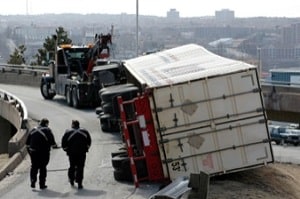49 CFR §392.9 Inspection of cargo, cargo securement devices and systems
(a) General. A driver may not operate a commercial motor vehicle and a motor carrier may not require or permit a driver to operate a commercial motor vehicle unless:
(1) The commercial motor vehicle’s cargo is properly distributed and adequately secured as specified in §§ 393.100 through 393.142 of this subchapter.

(2) The commercial motor vehicle’s tailgate, tailboard, doors, tarpaulins, spare tire and other equipment used in its operation, and the means of fastening the commercial motor vehicle’s cargo, are secured; and
(3) The commercial motor vehicle’s cargo or any other object does not obscure the driver’s view ahead or to the right or left sides (except for drivers of self-steer dollies), interfere with the free movement of his/her arms or legs, prevent his/her free and ready access to accessories required for emergencies, or prevent the free and ready exit of any person from the commercial motor vehicle’s cab or driver’s compartment.
(b) Drivers of trucks and truck tractors. Except as provided in paragraph (b)(4) of this section, the driver of a truck or truck tractor must:
(1) Assure himself/herself that the provisions of paragraph (a) of this section have been complied with before he/she drives that commercial motor vehicle;
(2) Inspect the cargo and the devices used to secure the cargo within the first 50 miles after beginning a trip and cause any adjustments to be made to the cargo or load securement devices as necessary, including adding more securement devices, to ensure that cargo cannot shift on or within, or fall from the commercial motor vehicle; and
(3) Reexamine the commercial motor vehicle’s cargo and its load securement devices during the course of transportation and make any necessary adjustment to the cargo or load securement devices, including adding more securement devices, to ensure that cargo cannot shift on or within, or fall from, the commercial motor vehicle. Reexamination and any necessary adjustments must be made whenever:
(i) The driver makes a change of his/her duty status; or
(ii) The commercial motor vehicle has been driven for 3 hours; or
(iii) The commercial motor vehicle has been driven for 150 miles, whichever occurs first.
(4) The rules in Paragraph (b) do not apply to the driver of a sealed commercial motor vehicle who has been ordered not to open it to inspect its cargo or to the driver of a commercial motor vehicle that has been loaded in a manner that makes inspection of its cargo impracticable.
For cases discussing this statute see:
- Wells v. U.S. Foodservice, Inc., 95 Fed. Appx. 302 (2004) (trucker failed to comply with statute’s obligation to check load);
- Franklin Stainless Corp. v. Marlo Transport Corp., 748 F.2d 865 (1984) responsibility for obviously improper loading generally rests on the carrier);
- Darby v. Sys. Transp. Inc., (unreported from Western District of New York in 1991) when employee was hurt when steel he was unloading from a truck trailer shifted onto his foot, court found nothing in 49 C.F.R. § 392.9 requiring truck driver to participate in or supervise the loading of the vehicle’s cargo).
- Trucker’s Exch. v. Border City Foods, 998 S.W.2d 434 (1999) (citing subsection 4 of this statute, Arkansas court found truck driver is not under the same obligation to inspect the cargo when it is shipped under seal)
 Plaintiff Attorney Legal Information Center
Plaintiff Attorney Legal Information Center